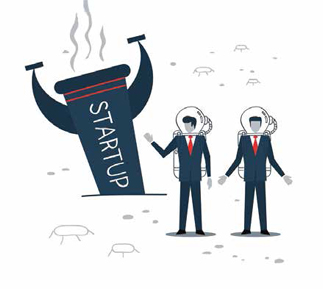
The failed entrepreneur is not a pariah; he could be an asset to any organisation which is looking for entrepreneurial leaders…
Since 2014, India has seen over 2,000 startups with great dreams across a variety of sectors— Retail Commerce, Healthcare, Education, Robotics… you name it! Fuelled by the hype created by indiscriminate funds and to some extent by the Start-Up India fever everywhere, young folks tired of looking for the perfect job decided to throw their hat into the entrepreneurial ring, raided their kids’ piggy bank or their family’s bank account and got started.
Sadly, many of these startup ships that sailed out into the venture sea have floundered and at last count, a thousand or more failures have happened in the startup landscape. The pink papers report almost with some vicarious pleasure the stores of the ‘down rounds’ that the erstwhile unicorn companies have had to consider and the blacklisting of some startups by the IITs have made front page news last week. All you have to do is google -` failed startups in India’ and a litany of reasons and umpteen lists will pop out, almost giving the impression that the start-up story is done and dusted.
The one stark fact that has been reported is that Israeli investors in startups have seen a seven times return on their money while in India it has been barely 10% more than the invested amount.
What does all this mean for the young person or the mid-life crisis-facing corporate executive who wants to embark on a startup? The KS Raghavan Incubation Centre at IIM Bangalore presents a good model for a staged approach that startups could consider. They are:

The one stark fact that has been reported is that Israeli investors in startups have seen a seven times return on their money while in India it has been barely 10% more than the invested amount
What makes startups fail and what are the obvious precautions budding entrepreneurs needs to take to avoid being one?
As my friend Ravi Gururaj, Chair of NASSCOM’s Product Form has said, “there is no value in trying to be the fiftieth online laundry service in a city”. In fact, I am biased enough to say that one should approach the entire B2C space with abundant caution. There is too much hype and the hiccups faced by Snapdeal and Ola show that when there are big sharks like Amazon and Uber in the startup waters who have no compulsion at all to show profits given the quantum of funding they have attracted, it is going to be extremely difficulty for a local “Johnny come lately” to succeed or even survive for long.
What one can learn from the success of Portea and Paytm in India is that if there is a substantial value proposition like home healthcare or cashless transactions that appeals to a large segment of the population, the likelihood of success is much more. What must be avoided are flights of fancy which might appeal to a few for a limited period of time and then get swept away by a slightly superior proposition from a new competitor. What looks like an amazing new idea— virtual reality and augmented reality or robots for loan processing —might prove to be so easy to copy that there is little that differentiates the winners in these spaces from the also-rans!
Another common reason for failure is a technology entrepreneur who has a great product idea but neither the vision nor the funding to build a marketing team which can take the idea to a larger market. As the marketing guru Ogilvy once said, “The world will not automatically beat a path of gold to the person with the better mousetrap.” Having a balanced team of marketing, technology and scaling personnel and if possible inducting people from the corporate sector who know what it is to build organisations is almost a prerequisite for taking startups to scale.
And if one does fail, what should be done? Fail fast is the maxim that Silicon Valley has adopted extremely well and many successful billionaires in California have a history of one and sometime even more failed startups behind them.
The failed entrepreneur is not a pariah, on the contrary, he could be an asset to any organisation which is looking for intrapreneurial leaders and a realistic assessment of why the startup failed, can help to ensure success the next time around. Hence, anyone with the entrepreneurial bug, should go ahead and do it. There is no harm in failing and in experiencing the start-up journey and of course enjoying the fruits of success if that does happen.
Go forth and conquer, my friends!
By Ganesh Natarajan